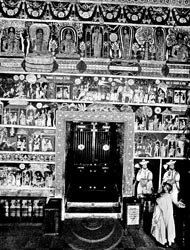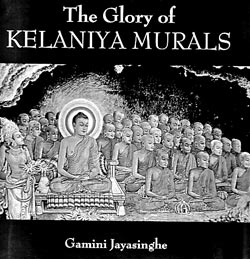
Kelaniya Raja Maha Vihara: Of painters and their paintingsKelaniya Raja Maha Vihara occupies a unique place among Buddhist places of worship in Sri Lanka. Apart from the fact that Kelaniya is one of the 16 places hallowed by a visit of the Buddha, the vihara is a fine example of artistry ranging from the 18th to 20th century. The paintings on the walls of the Kelaniya Vihara portray the 18th century Kandyan renaissance and 19th century Southern schools and the early 20th century Buddhist artistic revival.
Visitors to Kelaniya have a wide range of paintings to view and study. The well known photographer who has specialized in using his lens to capture temple paintings, Gamini Jayasinghe has just released his latest publication documenting these paintings. He calls the book 'The Glory of Kelaniya Murals' and takes us through the long period providing a fine record of the creative talent of our ancient painters. While the old painters are unknown except that they belonged to the 'sittara parampara', the 'aluth viharage' the paintings are by the highly respected painter of recent times, Soliyas Mendis. Gamini has captured it all. Saroja Wettasinghe in her text traces the history of Kelaniya from the 3rd century B.C onwards. In the early days Kelaniya had been the seat of a sub-king. As for the temple, while some say that King Yatthala Tissa, son of King Mahanaga and nephew of King Devanampiyatissa built the Viharaya initially, others say it had the patronage of a number of kings. Magha of Kalinga had looted the town and the temple and the vihara had been restored during the reign of King Vijayabahu III (1232-36) of Dambadeniya. After further restorations by King Parakramabahu VI (1411-66), the Portuguese burnt down the temple which was abandoned for 200 years. In 1767, Ven.Dehigaspe Atthadassi Thera, a pupil of Sangha Raja Velivita Sri Saranankara Nayaka Thera, initiated the restoration of Kelaniya when he was functioning as the chief monk of the temple. He had received assistance from King Kirti Sri Rajasinghe. Documenting the early paintings, Gamini opens with two wide angle views using them as double page spreads in the book. One is the view of the complete wall on the left of the entrance and the other, the right wall. While these two give the viewer an overview of the paintings, he later captures the close-ups of the paintings which are mostly Jataka stories and episodes from the life of the Buddha. While the different paintings have been separated by thin stripes, a story is related with a continuous flow with incidents being separated either by a tree or a stone, a building, a pillar or a river.
While Gamini records the paintings in detail, the text explains how the painters had drawn human figures, natural scenes and the background. The colours and techniques used in Kandyan paintings are also discussed. Gamini has also picked up the different gods portrayed in the paintings and identifies them separately giving the reader an opportunity to study the different facial and other features. The ceiling panels are something most of us may not notice - or even if we do, not pay much attention to. Gamini has devoted separate pages for these. They depict the 'Rashi Chakraya' - the 12 signs of the zodiac, 'Ashta Disapati Mandalaya' - the Lord of eight directions and the 'Kalpa Vruksha' - the tree of life. These are considered some of the best ceiling paintings which have withstood the test of time. Having devoted over 50 pages in the book to depict the 18th and 19th century paintings, Gamini uses the second half to record the Soliyas Mendis paintings. Dedicating the book to this "unhonoured and hidden artist", Gamini laments that a man with such extraordinary capabilities who had done a great work lasting many years should have died without recognition for his masterwork of Kelaniya. Soliyas Mendis paintings cover two main themes - the life of the Buddha and the history of Buddhism in Sri Lanka. The subdued colours are pleasing to the eye and make a distinct difference from the earlier paintings. After Helena Wijewardene started restoration work in the Kelaniya temple in 1930, Soliyas Mendis was assigned to do the paintings and he was sent to the Ajantha, Ellora and Bagh caves to study the paintings and gain inspiration. "He came back inspired and fired by the masterpieces in these Buddhist caves. But he had made no notes, copied no notes, taken no photographs. “Out of these masterpieces of the past in India, out of the extant ancient frescoes in Ceylon, out of his own imagination and out of the historical traditions of the Sinhalese, Soliyas Mendis re-created in modern Ceylon something of his own on the walls of Kelaniya for nearly twenty-five years," wrote D. B. Dhanapala in 'Among those present'. We admire and appreciate the great work by this unique personality in the regular visits we pay to Kelaniya. Now Gamini gives us the opportunity to browse through them at leisure. In fact, Gamini's photographs can be studied in detail thereby making Soliyas Mendis' effort all the more valuable and precious. With 'The Glory of Kelaniya Murals', Gamini Jayasinghe has added one more publication to the valuable collection he has been slowly but surely producing. It's fitting that the latest publication came out coinciding with the recognition he received from the Sarvodaya Trust Fund by being selected as a recipient of a Sarvodaya National Award 2006. With his publications, Gamini makes a vital contribution towards the preservation of valuable temple paintings through the medium of photography. May he gain more strength to carry on the good work he has started and present a complete history of temple paintings in Sri Lanka. |
|| Front
Page | News | Editorial | Columns | Sports | Plus | Financial
Times | International | Mirror | TV
Times | Funday
Times || |
| |
Copyright
2007 Wijeya
Newspapers Ltd.Colombo. Sri Lanka. |

